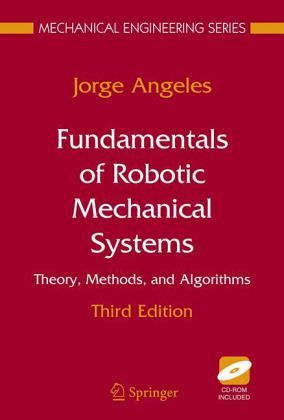Nicht lieferbar

Fundamentals of Robotic Mechanical Systems
Theory, Methods, and Algorithms
Versandkostenfrei!
Nicht lieferbar
Weitere Ausgaben:
Modern robotics dates from the late 1960s, when progress in the development of microprocessors made possible the computer control of a multiaxial manipulator. Since then, robotics has evolved to connect with many branches of science and engineering, and to encompass such diverse fields as computer vision, artificial intelligence, and speech recognition. This book deals with robots - such as remote manipulators, multifingered hands, walking machines, flight simulators, and machine tools - that rely on mechanical systems to perform their tasks. It aims to establish the foundations on which the d...
Modern robotics dates from the late 1960s, when progress in the development of microprocessors made possible the computer control of a multiaxial manipulator. Since then, robotics has evolved to connect with many branches of science and engineering, and to encompass such diverse fields as computer vision, artificial intelligence, and speech recognition. This book deals with robots - such as remote manipulators, multifingered hands, walking machines, flight simulators, and machine tools - that rely on mechanical systems to perform their tasks. It aims to establish the foundations on which the design, control and implementation of the underlying mechanical systems are based. The treatment assumes familiarity with some calculus, linear algebra, and elementary mechanics; however, the elements of rigid-body mechanics and of linear transformations are reviewed in the first chapters, making the presentation self-contained. An extensive set of exercises is included. Topics covered include: kinematics and dynamics of serial manipulators with decoupled architectures; trajectory planning; determination of the angular velocity and angular acceleration of a rigid body from point data; inverse and direct kinematics manipulators; dynamics of general parallel manipulators of the platform type; and the kinematics and dynamics of rolling robots. Since the publication of the previous edition there have been numerous advances in both the applications of robotics (including in laprascopy, haptics, manufacturing, and most notably space exploration) as well as in the theoretical aspects (for example, the proof that Husty's 40th-degree polynomial is indeed minimal - mentioned as an open question in the previous edition). Fundamentals of Robotic Mechanical Systems, Third Edition addresses robots at large - such as multi-fingered hands, walking machines, flight simulators, and machine tools - that rely on mechanical systems to perform their tasks. The author establishes the foundations on which the design, control, and implementation of the underlying mechanical subsystems are based. The treatment assumes familiarity with some calculus, linear algebra, and elementary mechanics; however, the elements of rigid-body mechanics and linear transformations are reviewed in the first chapters, making the presentation self-contained.
Features of this book are:
kinematics and dynamics of serial manipulators with decoupled architectures
trajectory planning
determination of the angular velocity and angular acceleration of a rigid body from point data
inverse and direct kinematics of general serial and of parallel manipulators
dynamics of general parallel manipulators of the platform type
kinematics and dynamics of rolling robots
This edition has been reorganized and includes new exercises as well as new photographs and all material have been updated where appropriate.
Features of this book are:
kinematics and dynamics of serial manipulators with decoupled architectures
trajectory planning
determination of the angular velocity and angular acceleration of a rigid body from point data
inverse and direct kinematics of general serial and of parallel manipulators
dynamics of general parallel manipulators of the platform type
kinematics and dynamics of rolling robots
This edition has been reorganized and includes new exercises as well as new photographs and all material have been updated where appropriate.




